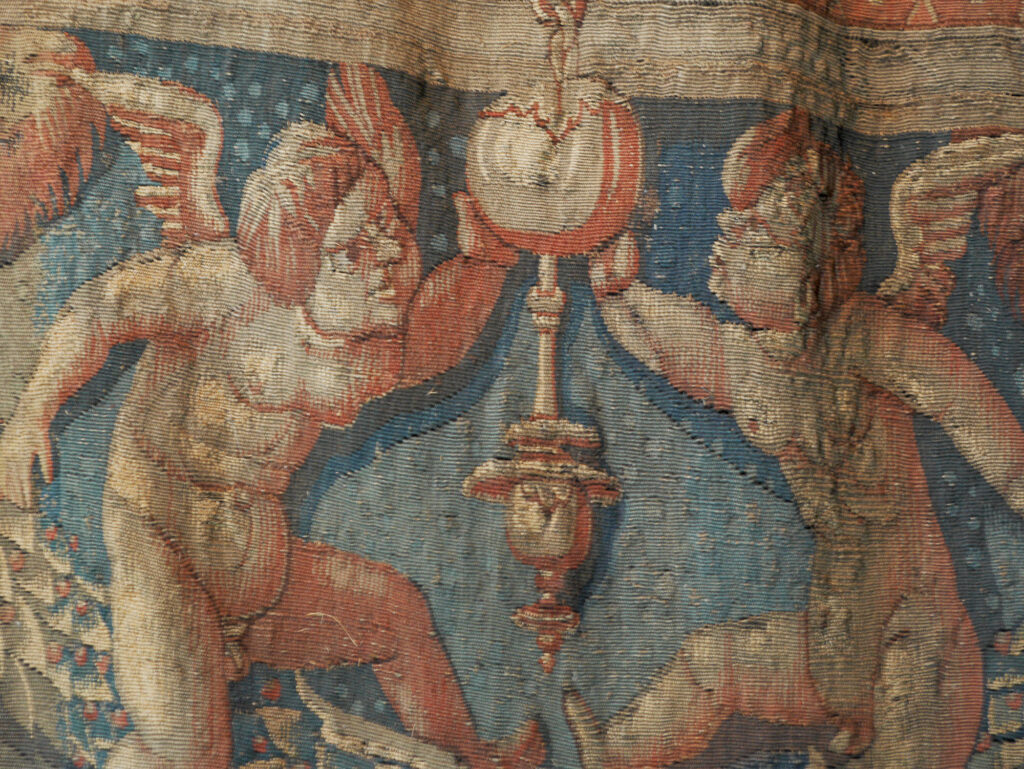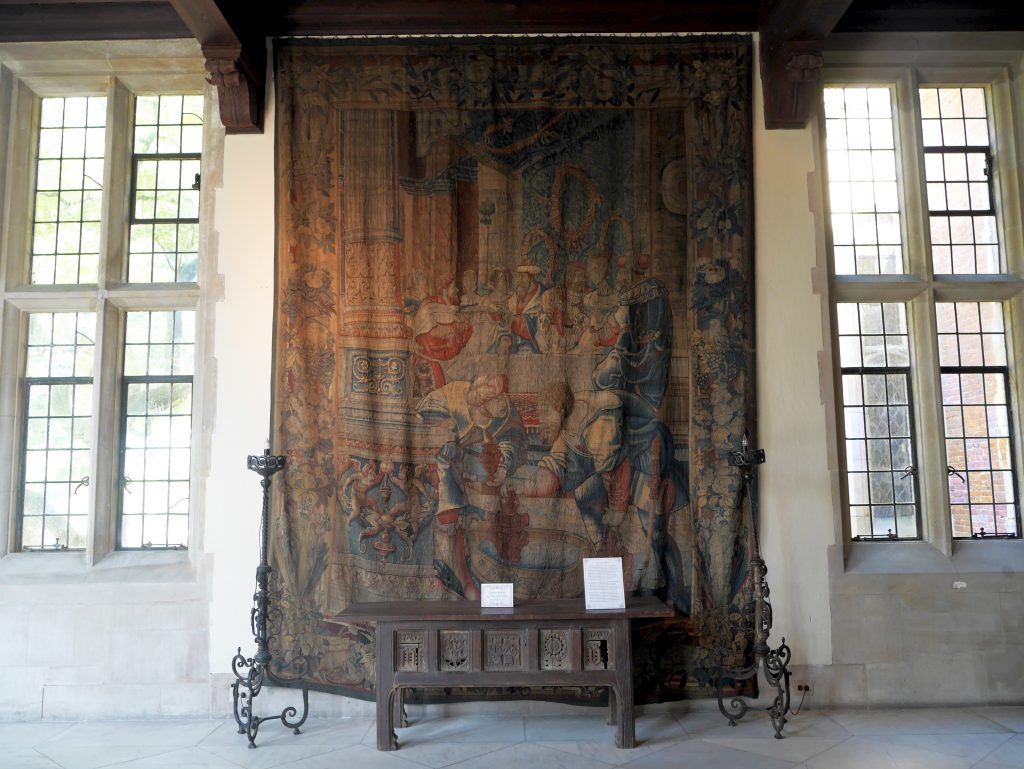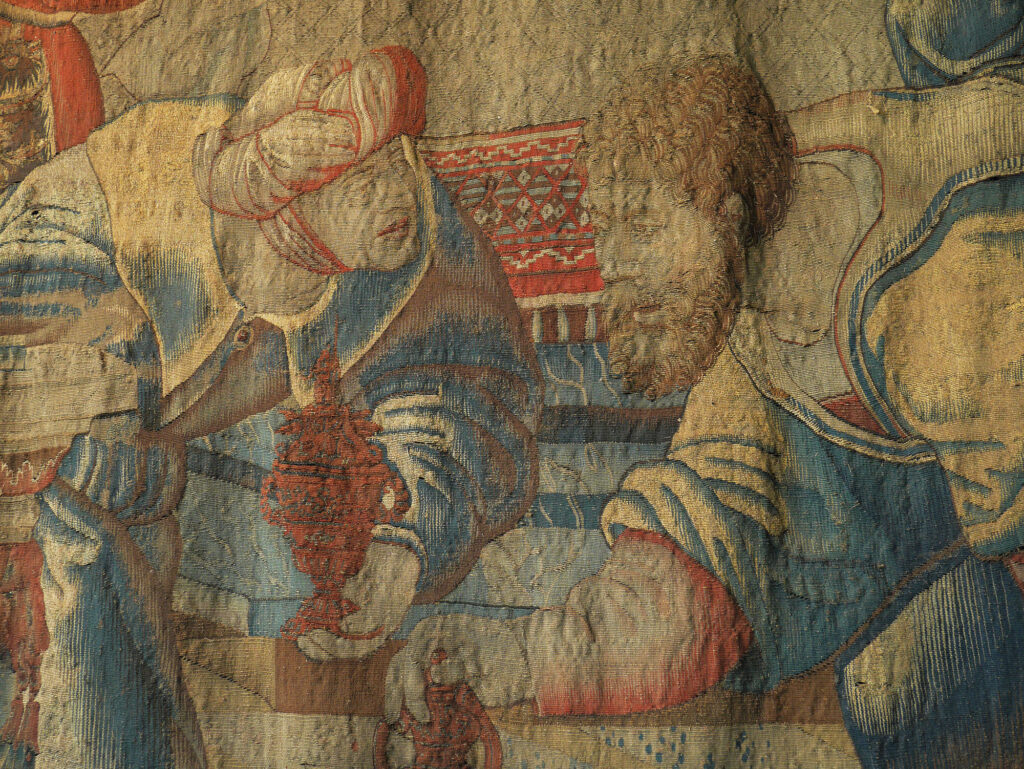Tapestry

Ever on the lookout for Renaissance-era treasures, Virginia-born art collector John Kerr Branch purchased an exceptional 16th C. tapestry in Europe early in the 20th C. He later built a Tudor-style home in Richmond to house the 14 ft x 10 ft tapestry, along with his growing collection. His home, now the Branch Museum of Design, 2501 Monument Ave., welcomes the return of this important Flemish tapestry dating from 1535-1540. On loan from the Dotts’ family, who are Branch descendants, the Dotts’ family, the tapestry was returned to the House in 2019. . The tapestry’s journey across Europe -from weavers and artists in the Netherlands to European courts to auction houses – and, finally, to Richmond is literally biblical, as is its subject: the Old Testament story of the marriage of Jacob and Rachel.
The Story of Jacob was a popular subject for Flemish Renaissance tapestry design in the 16th C. Jacob, called Israel, was the traditional ancestor of the people of Israel. Through deception he received his brother’s birthright. While escaping his brother’s wrath, he fell in love with Rachel. Rachel and Jacob’s path to the altar was operatic, to say the least, involving a dark tent, a substitute bride, and a love triangle.
All of this, and more, are intricately detailed in a narrative series of tapestries designed by Bernard van Orley, arguably the most important and influential Flemish artist of his generation. After the success of the original series tracing the sprawling story of Jacob, subsequent editions were reproduced. Of these other editions, many ended up in the hands of notable people, such as in the collection of Henry VIII of England and in the collection of King Sigismund Augustus of Poland. Scholars have been piecing together the fragmented history of six possible editions.
What all editions have in common are: the theme (Jacob), the designer (Orley), the weaver (Willem de Kempeneer), and the fabric (silk and wool). Only the original set of tapestries –upon which the others are based—include gold- and silver-wrapped threads. The Branch tapestry, which includes precious metal-wrapped threads, is thought to be part of the original set, commissioned by Holy Roman Emperor Charles V. This much-prized Story of Jacob set of tapestries is recorded in the collection of Charles’ son, Philip II of Spain.
It took many tapestries in a single set to illustrate the adventures of Jacob, who had 13 children and lived to be 147 years old. The Branch tapestry – The Marriage of Jacob and Rachel – depicts a climactic moment in his tormented timeline.
"The tapestry’s return represents a happy reunion. My great-grandparents built the house 100 years ago to house this beautiful work of art and others like it. It will personalize the Branch Museum and help tell the story of who built the house and why. It’s also an example of the principle of decorum, that is, appropriate decoration for specific rooms dedicated to a particular use. In this case, an art work depicting a marriage feast will hang in the original dining room of the Branch House,”
Walter Dotts, President of the Board of Trustees of The Branch Museum of Design
“"For the first time in this century, the public now has the opportunity to see the tapestry in its original place at the Branch House. This tapestry is evidence of the staying power of superb design and construction, and it is an apt reflection of The Branch Museum’s mission.”
Penny Fetcher, Former Executive Director of The Branch Museum of Design

The Story of Jacob: The Meeting and Marriage of Jacob and Rachel
In uninterrupted rhythm, indoor and outdoor spaces mingle in this masterpiece of Flemish Renaissance tapestry design. The narrative depicted is from Genesis, 29: 1-23, when Jacob- depicted at the far left- lifts the heavy stone lid from the well as Rachel approaches, waiting to allow her sheep to drink. Behind Rachel’s beautifully observed sheep, the story continues as Jacob greets his uncle, Laban, Rachel’s father. In the landscape beyond are further scenes from the stormy Old Testament love story: the embrace of Jacob and Rachel, Rachel with her older sister Lia, and Jacob fulfilling his side of the bargain and watching Laban’s sheep for seven years. A pair of exquisitely detailed columns demarks the entrance to a sumptuous interior where Lia, Laban, Jacob and Rachel can be recognised, seated at the feast celebrating Jacob and Rachel’s nuptials (although it will be Lia whom Laban leads to Jacob’s bed to consummate the union that night). The whole is surrounded by a border abundant with clusters of blooming flowers, ripe fruits and lifelike birds. The inscription on the scarlet-coloured banderol at the centre of the border captions the story: “And while the flock drinks, Laban is recognised thanks to the lamb / Jacob is engaged as servant amongst the staff / but Rachel’s beauty forces him to think of establishing a family line / Lia, the sister with rheumy eyes, robs her of the first nuptial bond”.[i]
Although a delightful and complete composition in its own right, this tapestry was originally part of a much larger series. In ten separate tapestries, the Story of Jacob unfolded, starting with Jacob’s birth and blessing by his blind father, Isaac; then Jacob’s departure from his parental home and dream of the ladder to Heaven; the Meeting and Marriage of Jacob and Rachel forms the third episode; in the next was depicted Lia’s trickery in the bridal chamber and, in the main field, the sharing of the sheep between Jacob and his in-laws; in the fifth tapestry, the departure of Jacob and his wives, children and servants from Laban’s house; the sixth tapestry showed the alliance between Jacob and Laban; in the seventh, the reconciliation between Jacob and his brother, Esau; the following tapestry depicted Jacob and the Sichemites; in the ninth, the sale of Jacob’s son Joseph by his brothers; and the final tapestry in the series showed Jacob and Joseph reunited.
No other tapestries from the same edition as the Burrell Collection’s tapestry are known for certain to have survived (although there are a couple of pieces, discussed further below, which could possibly have been part of it). Instead, we know the full sequence of all ten pieces thanks to a different edition of the Story of Jacob series, which is preserved in near-entirety in the Royal Museum of Art and History in Brussels (including fig.—).[ii] Also woven in wool and silk, like the Burrell Collection’s piece this set bears the mark of the Brussels-based master weaver Willem de Kempeneer. Interestingly, the one missing element from the set in the Brussels museum is the scene of the Marriage of Jacob and Rachel, which was cut away from the Meeting of Jacob and Rachel some time before 1900, and subsequently lost during the Second World War.
Thanks to the discovery of an inscription in the final tapestry in the Brussels edition, the identity of the designer of the series is confirmed: Bernard van Orley, court painter to Margaret of Austria and to Mary of Hungary and, arguably, the most important and influential Flemish artist of his generation.[iii] The design of the Meeting and Marriage of Jacob and Rachel benefits from a clear and legible overriding composition, leading the viewers’ eyes from left to right in a marvellous wave of stooping and standing paired figures, half-way through lingering on the only lone figure as the elegant and expectant Rachel holds our eye just as she captivated Jacob at first sight. This overall clarity of composition is combined with wonderful attention to detail, whether it be the studs on Jacob’s boots, or the fantastical landscape viewed in the far distance. The weavers’ representational skills have been stretched, from recreating the effect of the rippled waters of the well, to the woolly coats of the sheep, to the smooth, cold sheen of the marble floor tiles. Bernard van Orley’s clarity of design can be appreciated throughout: the wealth of decorative surface pattern in the right hand section delights but does not overpower the tapestry design, which remains anchored by the answering forms of Jacob and his companion at the well on the left with the two servants at the wine cooler on the right, and by the strong verticals of the tree-trunks picked up by columns and piers of the palace.
As has been suggested by the highly respected tapestry scholars, Guy Delmarcel and Tom Campbell, it is likely that although van Orley’s vision guided the overall composition of the ten-piece Jacob series, he was probably assisted by other artists in the detail of the design and certainly in the painting of the cartoons.[iv] These artists perhaps included Michiel Coxcie and Pieter Coecke van Aelst, the latter of whom might have spent part of his early career as a contractual cartoon-painter working for van Orley. This combination of van Orley, Coxcie and Coecke was apparently echoed around a decade later in the design of the Story of Abraham, which was also woven under Willem de Kempeneer’s direction, and which shares some strikingly similar figure types to those in the Story of Jacob. An earlier instance of such collaborative tapestry cartoon design by Bernard van Orley has also been suggested here for the Honours series (see cat.— [46.129, .130]).
[i] “QUA[N]DOQZ [for QUANDOQUE] GREX POTAT LABAN COGNOSCITUR AGNO / SUMITUR INTER VERNAS JACOB FAMULUS / SED PENSARE STIPEM RACHAELIS FORMA COEGIT / PRERIPUIT [for PRECIPUIT] THA[L]AMOS HUIC LYA LIPPA SOROR”: transcription published by Lessing 1900 (p.3); translation by author.
[ii] Brussels, Royal Museums of Art and History, invs.8584-93: see Crick-Kuntziger 1956 (cats.24-33) and Asselberghs 1972.
[iii] Joos 1985.
[iv] Delmarcel 1999 (p.124); Thomas P. Campbell in New York 2002 (pp.300-301). For the Story of Abraham, see T. Campbell 2003.

Date and place of production
Date and place of production:
Thanks to the marks woven into the lower left and right corners of the Meeting and Marriage of Jacob and Rachel, the place of production is clearly recorded: Brussels, under the direction of the master weaver Willem de Kempeneer. The precise date when Bernard van Orley designed the Story of Jacob remains uncertain, but for stylistic reasons, the cartoons have been attributed to the late 1520s, or to around 1531 to 1532.[v] This would coincide neatly with the dating of the weaving of the ten-piece series: one of the first editions was completed as early as 1534, with other made throughout the 1530s. Four editions are traceable from documents: There was a much-prized Story of Jacob set recorded in the collection of Philip II of Spain, which the great Brussels tapestry scholar Marthe Crick-Kuntziger suggested might have been the original first edition of the Story of Jacob, including gold and silver metal-wrapped threads and made for Philip’s father, the Holy Roman Emperor Charles V.[vi] Willem de Kempeneer evidently, however, realised the appeal of his Story of Jacob series, continuing to produce editions on speculation for sale to dealers and on the open market. In January 1534, Willem de Kempeneer sold a ten-piece set of the Story of Jacob, woven in wool and silk, to the Antwerp-based dealer, Joris Vezeleer.[vii] Probably in the early 1530s, Henry VIII acquired a ten-piece Story of Jacob set, almost certainly woven just in wool and silk, which might have been that provided by Vezeleer.[viii] The provenance of the edition now in Brussels stretches all the way back to Cardinal Lorenzo Campeggi, who died in 1539; it has been suggested that it might be this edition, rather than that acquired by Henry VIII which de Kempeneer sold to Vezeleer. In 1539, the de Kempeneer workshop contracted to provide the Spanish merchant Diego Arranda with another ten-piece edition, in a subsequent contract described as 13-piece.[ix]
At least five, possibly six, partial editions survive: Very recently, a fragment from a Story of Jacob set based on the same cartoon as the Burrell tapestry, came to light came to light in an American private collection: it represents just the Marriage of Jacob and Rachel (fig.—).[x] Unfortunately no weaver’s mark is detectable, but note-worthily enough, this edition of the Story of Jacob is woven with precious metal-wrapped threads as well as wool and silk. In the late nineteenth or early twentieth century, this fragment was acquired by the Richmond, Virginia-based collector, John Kerr Branch, and has remained with his family by descent. This provenance, together with the copious amounts of metal-wrapped thread in the weaving, rules it out from being the Marriage fragment lost from the set now in Brussels; instead, it is conceivable that this might have been part of the primary edition for Charles V proposed by Crick-Kuntziger. Secondly, there is the near-complete Campeggi set now in Brussels. A third partial set of six tapestries based on the same Jacob cartoons is in the Uffizi in Florence; its Meeting and Marriage of Jacob and Rachel, like the Brussels set, is in two separate pieces, although in this instance both have survived. This edition also bears the weaver’s mark of Willem de Kempeneer (long misidentified as that of Willem de Pannemaker), but is woven mainly, perhaps exclusively, in wool.[xi] A fourth edition, now fragmentary and borderless, was given by Bishop Charles de Croy (1505-1565) to the cathedral of Tournai; fragments of the first, seventh, nineth and tenth tapestries in the series remain in the collection of the cathedral.[xii] From a fifth edition, a very fine wool and silk tapestry of the Reconciliation of Jacob and Esau, again with de Kempeneer’s mark, appeared on the art market in 1998 (fig.—): its height corresponds with that of the Burrell’s Meeting and Marriage of Jacob and Rachel (in particular, the height at the centre of the Burrell’s piece where it has stretched the least).[xiii] In palette, detailing and border design, the Reconciliation of Jacob and Esau tapestry is so close to the Burrell’s Meeting and Marriage of Jacob and Rachel that it is highly likely that they were originally made as part of the same set. Unfortunately, not enough provenance can be traced back for either piece to prove this for certain. A further, very fine fragment depicting just Jacob’s Dream from the second tapestry in the series (Fine Arts Museums of San Francisco) might also conceivably be from this edition: duplicating the Jacob’s Dream scene in Brussels, it is beautifully woven with wool and silk, ruling it out both from the wool-only Florence set and from the precious metal-wrapped thread of the edition in the private collection in Virginia.[xiv] The borders of the Jacob editions in the American private collection, in Florence, on the art market and in the Burrell Collection all follow the same design conventions of clumps of fruit, flowers and birds, regularly spaced along a thick, scaly, anchoring stem. The foliage in the borders of the edition in Brussels, in contrast, is much densely packed, with virtually no ground visible.
The set from which the Burrell Collection’s Meeting and Marriage of Jacob and Rachel comes was probably made on speculation by Willem de Kempeneer for sale on the open market. Its weaving date can be attributed to the 1530s: production seems concentrated to this decade, with the Vezeleer edition completed by 1534, Henry VIII probably acquiring his in the early 1530s, Campeggi’s predating his death in 1539, and the Arranda edition completed by 1540. It is worth noting, though, that Willem de Kempeneer remained active until at least 1544, when he was embroiled in a court case for fraudulently “enhancing” the surface of tapestries with paint after completion of the weaving.[xv] The Jacob series also continued to find an audience: the cartoons continued to be used, adapted and updated in subsequent versions by his son Jan de Kempeneer. Examples of these updated Jacob editions survive in the Wawel castle in Krakow and also in the Fine Arts Museums of San Francisco.[xvi]
Despite his run-ins with the law, Willem de Kempeneer was one of the more successful master weavers working in Brussels during the first half of sixteenth century: important series woven under his direction or collaboration included the Story of Abraham and Scenes from Genesis, and collectors of his work ranged from Henry VIII to King Sigismund Augustus of Poland. The Meeting and Marriage of Jacob and Rachel provides testament to the skill of de Kempeneer’s workshop, whose expert handling of the complex composition ranges from confident swathes of weaving across areas like the drapery and landscape detailing, to sophisticated and precise manipulation in the weave of the slits and eccentric weft (deviating from the standard weaving grid) to model areas like locks of hair and facial features; careful hatching of colours also allows for wonderful graduations between light and shade, whilst inventive use of undyed wools has been made to achieve the effect of the sheep’s coats. This combination of masterful design by van Orley and talented weaving under de Kempeneer’s direction makes the Meeting and Marriage of Jacob and Rachel one of the most important Renaissance tapestries in Sir William’s collection.
[v] Friedländer 1909 (p.156), attributes them to 1528; Thomas P. Campbell in New York 2002 (p.300), slightly later to 1531-32.
[vi] Crick-Kuntziger 1954 (pp.29-30).
[vii] Crick-Kuntziger 1954 (annexe III).
[viii] T. Campbell 2007 (pp.220-222).
[ix] Crick-Kuntziger 1954 (annexe IV).
[x] Private Collection, Virginia: 163 x 124 cm. I am very grateful to Margaret Chace for bringing this tapestry to my attention.
[xi] Florence, Uffizi, invs.31,48,55,59,70, 108: see N.A. 1979 (pp.1050-1053, cats.Ar1-Ar6).
[xii] Tournai, cathedral: Crick-Kuntziger 1954 (p.30); illustrated by Göbel 1923 (part 2, fig.198), but erroneously discussed (following a mistake by Soil 1892, p.284, he confuses them with a partially surviving Story of Joseph set, also in Tournai, delivered by Jean Martin the Younger, a Tournai- based tapestry weaver to Charles de Croy).
[xiii] Last known location: Paris, Galerie Chevalier, March 1997.
[xiv] San Francisco, Fine Arts Museums, inv.77.14(de Young): see Bennett 1992 (cat.25).
[xv] Schneebalg-Perelman 1961.
[xvi] Krakow, Wawel castle; San Francisco, Fine Arts Museums, invs.1928.8,1930.25, 1930.24: see Bennett 1992 (cats.26,27,28).
